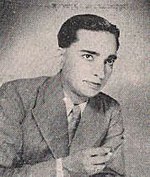Y. V. Rao
Y. V. Rao | |
|---|---|
 Y. V. Rao in 1948 | |
| Born | Yaragudipati Varada Rao 30 May 1903 |
| Died | 13 February 1979 (aged 75) |
| Occupation |
|
| Years active | 1930–1968 |
| Relatives | Rajam (ex-wife) Kumari Rukmini (wife) Nungambakkam Janaki (mother-in-law) Lakshmi (daughter) Aishwarya (grand daughter) |
Yaragudipati Varada Rao (30 May 1903 – 13 February 1979[1]) was an Indian film actor, screenwriter, director, editor, and producer, known for his works primarily in the Telugu cinema, Kannada cinema, and Tamil Cinema.[2] Rao plunged into theatre and did a few stage plays before moving to Kolhapur and Bombay to act in silent films.[3][4] Regarded as one of the greatest filmmaking pioneers of the Cinema of South India,[3][1] he made motion-pictures across Telugu, Kannada, Tamil, Konkani and Hindi languages, apart from silent films.[3][1] Rao started his career as a lead actor in many silent films such as Garuda Garva Bhangam, Gajendra Moksham and Rose of Rajasthan.[1][5]
Rao made significant contributions to South cinema during the Crown rule in India, Rao's 1934 film Sati Sulochana was the first talkie film in the Kannada language.[1] In 1937, he directed the hagiographical classic Chintamani, the Tamil sleeper hit ran for a year with highest estimated footfall at a single screen in India, and British Ceylon.[6] Rao's 1938 film Swarnalatha was one of the finest political drama scripted by Ayyalu Somayajulu; with Prohibition as the central theme, in which Rao played the lead. The film was shot extensively at Newtone Studios, Kilpauk, during Madras Presidency.[1] Rao's 1940 film, Viswa Mohini, is the first Indian film, depicting the Indian movie world, scripted by Balijepalli Lakshmikanta Kavi, starring superstar V. Nagaiah.[7] Rao subsequently made the mythology sequel films Savithiri (1941), and Sathyabhama (1942) casting thespian Sthanam Narasimha Rao.[8][4]
Personal life[edit]
Yaragudipati Varada Rao was born in Nellore in the then Madras Presidency of British India in May 1903. In the late 1920s, he moved to Madras and ventured into Kannada cinema.[3] He married Kumari Rukmini who was paired with him in Lavangi (1946). Indian film actress Lakshmi is their daughter.[9]
Early career[edit]
Rao moved into film direction and made silent films such as Pandava Nirvan (1930), Pandava Agnathavaas (1930) and Hari Maya (1932). In 1932, a Marwari businessman, Chamanlal Doongaji from Bangalore, launched South India Movie Tone. The company made Sati Sulochana, the first talking picture in Kannada language with an expense of ₹40,000 (US$560). Rao directed this blockbuster film shot at Chatrapathi Cinetone, in Kolhapur; the shooting took eight weeks. He then directed Hari Maya (1932) that starred his first wife, Rajam.[3]
Filmography[edit]
- As Director
- 1930: Pandava Agyathavas (Silent),
- 1930: Sarangadhara (Telugu),
- 1932: Hari Maya (Kannada- Director),
- 1934: Sati Sulochana (Kannada - Cast),
- 1935: Naganand (Hindi),
- 1936: Bhama Parinayam (Tamil),
- 1937: Chintamani (Tamil),
- 1938: Bhakta Meera (Tamil),
- 1938: Swarnalatha (Tamil),
- 1939: Malli Pelli (Telugu - Cast),
- 1940: Viswa Mohini (Telugu - Cast),
- 1941: Savithiri (Tamil - Cast, Singer),
- 1942: Sathyabhama (Telugu - Cast),
- 1944: Thasildar (Telugu - Cast),
- 1946: Lavangi (Tamil),
- 1948: Ramadas (Tamil),
- 1950: Jeevit Amche Ashe (Konkani),
- 1952: Manavathi (Telugu-Tamil),
- 1953: Manjari (Telugu - Cast),
- 1956: Bhagya Chakra (Kannada),
- 1958: Sri Krishna Garudi (Telugu),
- 1961: Nagarjuna (Telugu-Kannada),
- 1963: Hennina Balu Kanneru (Kannada)
- As Producer - Telugu
- 1964: Thotalo Pilla Kotalo Rani
- 1965: Aakasaramanna
- 1966: Bhulokamlo Yamalokam
- 1966: Loguttu Perumaallu Keruka
- 1967: Devuni Gelichina Manavudu
- 1967: Gopaludu Bhupaludu
- 1968: Circar Express
- 1968: Pala Manasulu
- 1969: Ardharathri (Cast)
- 1969: Love in Andhra
- 1969: Takkari Donga Chakkani Chukka
- 1970: Paga Sadhistha
- 1971: Revolver Rani
- 1972: Monagadosthunnadu Jagratha[4]
References[edit]
- ↑ 1.0 1.1 1.2 1.3 1.4 1.5 Guy, Randor (26 July 2014). "Swarnalatha (1938)". The Hindu.
- ↑ Narasimham, M. L. (28 May 2011). "Malli Pelli (1939)". The Hindu.
- ↑ 3.0 3.1 3.2 3.3 3.4 Guy, Randor (22 August 2003). "A revolutionary filmmaker". The Hindu. Archived from the original on 19 November 2016. Retrieved 19 November 2016.
- ↑ 4.0 4.1 4.2 "Y. V. Rao Fimograph". Indiancine.ma.
- ↑ "Viswamohini review Indian express". hindi-films-songs.com.
- ↑ "An unforgettable superhit". The Hindu. 3 March 2008.
- ↑ narasimham, m.l. "Viswamohini (1940)".
- ↑ "A revolutionary filmmaker". The Hindu. Chennai, India. 22 August 2003. Archived from the original on 17 January 2004.
- ↑ Randor Guy (25 May 2013). "Blast from the past - lavangi 1946". "The Hindu". Archived from the original on 10 September 2013. Retrieved 19 November 2016.
- 1903 births
- 1979 deaths
- Indian male film actors
- Tamil film directors
- Telugu film editors
- Telugu film directors
- Kannada film producers
- Telugu film producers
- Nandi Award winners
- Kannada film directors
- Telugu screenwriters
- Indian editors
- Indian cinematographers
- Indian silent film directors
- 20th-century Indian male actors
- Male actors from Andhra Pradesh
- People from Nellore district
- Indian male stage actors
- Film producers from Andhra Pradesh
- Screenwriters from Andhra Pradesh
- Film directors from Andhra Pradesh
- 20th-century Indian film directors
- 20th-century Indian dramatists and playwrights
- Film editors from Andhra Pradesh
- Konkani-language film directors
- 20th-century Indian screenwriters
